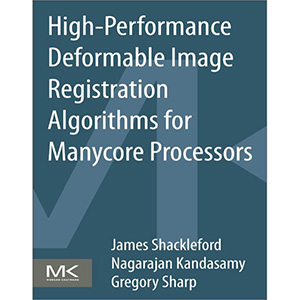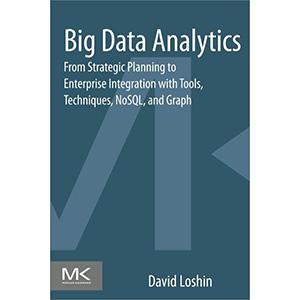Wow! eBook: Accelerating MATLAB with GPU Computing - 5 new eBooks |  |
- Accelerating MATLAB with GPU Computing
- High Performance Deformable Image Registration Algorithms for Manycore Processors
- Big Data Analytics
- User Interface Inspection Methods
- Credible Checklists and Quality Questionnaires
| Accelerating MATLAB with GPU Computing Posted: 06 Feb 2014 04:05 AM PST
Book DescriptionBeyond simulation and algorithm development, many developers increasingly use MATLAB even for product deployment in computationally heavy fields. This often demands that MATLAB codes run faster by leveraging the distributed parallelism of Graphics Processing Units (GPUs). While MATLAB successfully provides high-level functions as a simulation tool for rapid prototyping, the underlying details and knowledge needed for utilizing GPUs make MATLAB users hesitate to step into it. Accelerating MATLAB with GPUs offers a primer on bridging this gap. Starting with the basics, setting up MATLAB for CUDA (in Windows, Linux and Mac OS X) and profiling, it then guides users through advanced topics such as CUDA libraries. The authors share their experience developing algorithms using MATLAB, C++ and GPUs for huge datasets, modifying MATLAB codes to better utilize the computational power of GPUs, and integrating them into commercial software products. Throughout the book, they demonstrate many example codes that can be used as templates of C-MEX and CUDA codes for readers’ projects. Download example codes from the publisher’s website: http://booksite.elsevier.com/9780124080805/
Table of Contents Appendix 1. Download and install CUDA library Book Details
Related Books
The post Accelerating MATLAB with GPU Computing appeared first on Wow! eBook. |
| High Performance Deformable Image Registration Algorithms for Manycore Processors Posted: 06 Feb 2014 04:00 AM PST
Book DescriptionHigh Performance Deformable Image Registration Algorithms for Manycore Processors develops highly data-parallel image registration algorithms suitable for use on modern multi-core architectures, including graphics processing units (GPUs). Focusing on deformable registration, we show how to develop data-parallel versions of the registration algorithm suitable for execution on the GPU. Image registration is the process of aligning two or more images into a common coordinate frame and is a fundamental step to be able to compare or fuse data obtained from different sensor measurements. Extracting useful information from 2D/3D data is essential to realizing key technologies underlying our daily lives. Examples include autonomous vehicles and humanoid robots that can recognize and manipulate objects in cluttered environments using stereo vision and laser sensing and medical imaging to localize and diagnose tumors in internal organs using data captured by CT/MRI scans. This book demonstrates:
Table of Contents Book Details
Related Books
The post High Performance Deformable Image Registration Algorithms for Manycore Processors appeared first on Wow! eBook. |
| Posted: 06 Feb 2014 03:56 AM PST
Book DescriptionBig Data Analytics will assist managers in providing an overview of the drivers for introducing big data technology into the organization and for understanding the types of business problems best suited to big data analytics solutions, understanding the value drivers and benefits, strategic planning, developing a pilot, and eventually planning to integrate back into production within the enterprise.
Table of Contents Book Details
Related Books
The post Big Data Analytics appeared first on Wow! eBook. |
| User Interface Inspection Methods Posted: 06 Feb 2014 03:51 AM PST
Book DescriptionUser Interface Inspection Methods succinctly covers five inspection methods: heuristic evaluation, perspective-based user interface inspection, cognitive walkthrough, pluralistic walkthrough, and formal usability inspections. Heuristic evaluation is perhaps the best-known inspection method, requiring a group of evaluators to review a product against a set of general principles. The perspective-based user interface inspection is based on the principle that different perspectives will find different problems in a user interface. In the related persona-based inspection, colleagues assume the roles of personas and review the product based on the needs, background, tasks, and pain points of the different personas. The cognitive walkthrough focuses on ease of learning. Most of the inspection methods do not require users; the main exception is the pluralistic walkthrough, in which a user is invited to provide feedback while members of a product team listen, observe the user, and ask questions. After reading this book, you will be able to use these UI inspection methods with confidence and certainty. Table of Contents Book Details
Related Books
The post User Interface Inspection Methods appeared first on Wow! eBook. |
| Credible Checklists and Quality Questionnaires Posted: 06 Feb 2014 03:49 AM PST
Book DescriptionCredible Checklists and Quality Questionnaires starts off with an examination of the critical but commonly overlooked checklist method. In the second chapter, questionnaires and surveys are discussed. Asking questions sounds simple, but the hard truth is that asking questions (and designing questionnaires) is a difficult task. This chapter discusses being mindful of the choice of words, order of questions and how early questions influence later questions, answer scales and how they impact the user response, questionnaire design, and much more. The final chapter provides examples of some common questionnaires (both free and fee-based) for assessing the usability of products. After reading this book, readers will be able to use these user design tools with greater confidence and certainty. Table of Contents Book Details
Related Books
The post Credible Checklists and Quality Questionnaires appeared first on Wow! eBook. |
| You are subscribed to email updates from Wow! eBook To stop receiving these emails, you may unsubscribe now. | Email delivery powered by Google |
| Google Inc., 20 West Kinzie, Chicago IL USA 60610 | |





Tidak ada komentar:
Posting Komentar